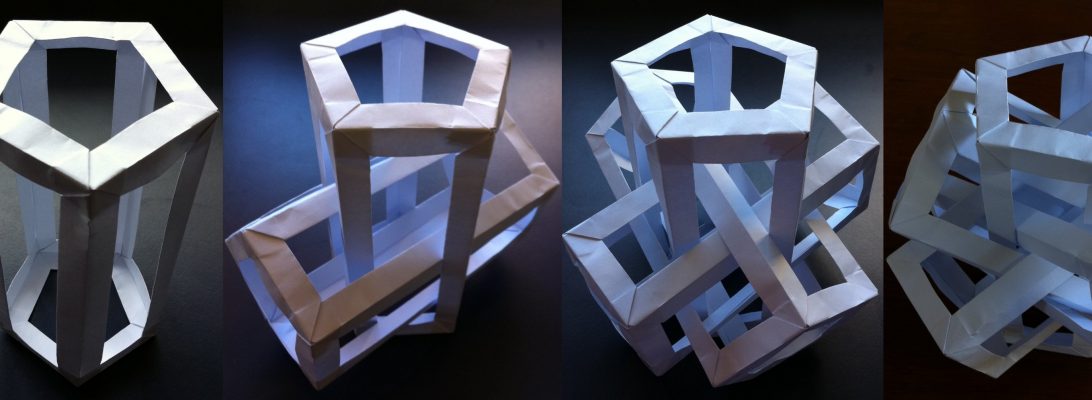Tucked away in an inconspicuous corner of the deserted clearing, nestled almost invisibly among the leaf litter, the first signs of civilization were found in the form of a rough-hewn but definitely hominid-worked paper offering. For whom, to what, why … we shall never know:

Followers of the blog will notice occasional references to paper making pursuits. This post looks at the most recent results of a paper making workshop I attended in early July 2023. I had previously (back in 2019) been a member of PAQ (Paper makers and Artists, Queensland) but found full time work made attending events difficult. Now I am retired I have more freedom, so reapplied for membership.
The group’s interests in paper are diverse – from botanical paper making, monoprinting, encaustics, stitching, collage, pulp sculpture and more – my interests are (fairly narrowly?) folding, but it is important to have ones interests informed by a wider palette so I am very much the learner in that group.
Previous workshops I made sheets with finely beaten banana stem and cotton display board, day lily and lemongrass pulp, and still have some of the paper from that session. This session we pulped banana stem (coarsely this time) and mixed it with lemon grass, Philodendron, and South African Pigeon Grass stem, in various combinations. The pulp was added to water, then a suspension-aid made from water soaked chopped okra, which generates a mucilage that makes the vat water more goopy, helping the pulp to stay in suspension longer before settling out. The results were much coarser paper, but it presented an interesting challenge to see what I could fold from it.
I first pressed then dried my sheets, brought home still dripping. I carefully separated them from their couching sheets (old torn up bed linen) and selected sheets to process further. Using a fairly stiff batch of Methyl Cellulose, I stuck sheets to my glass and let them dry, reasoning (correctly it turns out) that the MC would make the sheets more pliable and bind the fibres more closely together (given some of them were very loosely bound, this seemed like a good plan).

Each pulp combination resulted in sheets with different folding characteristics – some stiff, some soft, some strong. After some consideration I selected surface crenellation techniques that suited the sheet and resulted in a planned abstract form – most modelled after real organic recognizables.

Using an A5 sheet of banana stem and cotton, finely beaten to make a fine and strong crinkly paper – I decided to try a tessellation (the quill treatment from Steven Casey’s “Echidna”), and was deighted with how resilient the sheet was, how well it took fine precise folds.
I next took my loosest sheet – mostly coarse banana fibre, and gently gathered opposing ends of the roughly A4 sheet, tying them with offcut paper strips, draped it over a large bowl and then using my mist sprayer, I misted it with slightly diluted MC, then left it to dry. The slumped form made a crude bowl which forms the base of the whole piece. Handling it pre-spray was fairly horrible, it shed fibres and felt like it would disintegrate at any moment.

I remember a large-scale pleated vessel technique showcased by Paul Jackson, so took an A4 sheet of mostly Philodendron and Sisal paper and pleated, corrugated and then stretched the folds in the pleats to form nice curved shapes that reminded me of a seed pod or sea urchin.

One of the most important (to me) experiments for the day was to add a mould on top of the screen in the paper making frame. I took a sheet of corrugated cardboard, cut a perfect pentagon-shaped hole, placed it on the screen and them pulled a sheet from the vat – the pulp confined itself to the hole, gave me some lovely deckle edges all the way round. Ultimately I could pull pentagons to fold roses, but I will need better pulp and a less fragile mould for that. The resulting pentagon I then accordion pleated concentrically to make a form reminiscent of a brittle star. Wetting it after wrestling it into shape and then letting it dry now makes that form permanent.

Using an A3 sheet of white board and day lily paper that had holes, I cut a square and fashioned a spiral shell-based shape, inspired by work by Davor Vinko to complete the pieces – the light shell provides colour balance from the other, darker shapes.

The assemblage I have called “The Offering”, and is enough, hopefully, to appease the paper gods and let them look favourably on my further exploration.



Brilliant!
…an interesting process at least
Superb offering Peter, I’m sure you’ve earned access to offering 🫴 more to the gods 😉
Many thanks Doug. The process of making the media and then making with the media was instructive indeed